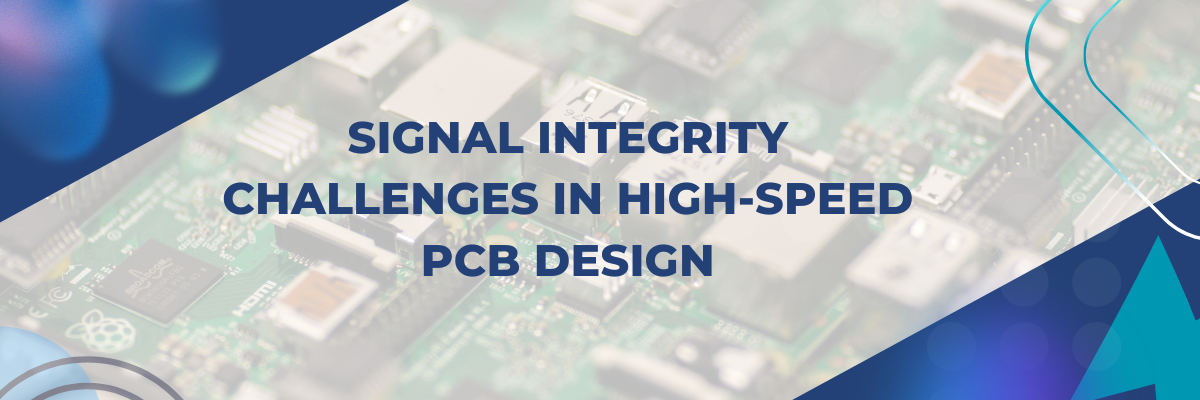Signal losses and attenuation are common issues, especially in high-speed and high-frequency printed circuit board (PCB) applications, which must be overcome. Electrical signals get distorted because of various issues such as electromagnetic interference (EMI), radio frequency interference (RFI), crosstalk, and so on. Improving signal integrity is a crucial aspect to facilitate seamless communication and maintain data transfer rates in modern electronics. The number of such high-frequency PCB applications involving high-speed data transmission has been on the rise over the last few years. Advancements in PCB design have helped improve signal integrity by addressing the causes. This post discusses various signal integrity challenges in PCB design and their solutions.
Overview of Signal Integrity
With the shrinking size of electronics and increasing design complexities, the signal integrity aspect has become extremely crucial. System integrity or SI is a measure of the changes in an electrical signal from the time it enters the circuit till it exits. So, this can be displayed in the form of a wave. If there is too much variation in the waveform, this indicates lost or distorted signals, which will not seamlessly reach the end of the circuit. This original signal is lost or distorted due to issues such as EMI, crosstalk, impedance, and more, especially common in high-frequency applications. The next topic explores the solutions to overcome SI challenges in high-speed PCB design.
Signal Integrity: Challenges and Solutions
The key to overcoming most signal integrity issues lies in the expertise of the PCB designer. Here are some SI challenges in high-speed design and their solutions.
- Impedance mismatch: Mismatch in the impedance between the transmission line and the components causes signal reflections, leading to data loss and errors. This occurs when the characteristic impedance of the PCB traces doesn’t match the impedance of the source or destination.
Solution: A good PCB design with controlled trace width is key. Also, PCB designers must consider materials with appropriate dielectric strength as well as the distance between traces. Controlled impedance prevents signal distortion.
- Electromagnetic interference (EMI): In high-frequency applications, traces or vias can act as antennas to capture signals. This causes coupling with signals from other devices in the periphery. Also, some components mounted on a circuit board are EMI sensitive, while others may produce EMI. This clash of signals hampers the functioning of the board and device.
Solution: Again, the solution lies in a correct PCB design. To avoid internally produced EMI, sensitive components must be placed away from the sources of EMI. Designers can also shield sensitive components. Proper grounding and shielding are essential to reducing external noise and EMI. A solid ground plane helps maintain a consistent reference for the signals, reducing noise coupling.
- Voltage fluctuation: Voltage fluctuations are closely tied to signal integrity issues and can significantly affect analog and mixed-signal circuits. These power integrity problems can lead to signal degradation, causing erratic behavior or potential damage to devices.
Solution: This challenge can be overcome by a flawless PCB design. Designers place decoupling and bypass capacitors close to the power pins of sensitive components to filter out high-frequency noise. A solid ground plane also helps ensure that the return current has a low-resistance path, reduced noise and improved power integrity.
- Crosstalk: Crosstalk is a common issue in high-speed PCB applications. This occurs when the nearby signals in high-speed traces couple their electric and magnetic fields. The unwanted signal originates from an aggressor trace that couples with the signal on any adjacent transmission line. This involves various types of coupling such as conductive, capacitive, and inductive.
Solution: To overcome this issue, place traces as far apart as possible and avoid running high-speed signals near sensitive ones. Use ground planes between signal layers so that they act as shields to prevent EMI. Differential signaling, where two signals are transmitted in opposite polarities, can also help reduce crosstalk.
The key to overcoming signal integrity issues lies in the skills of the PCB designer. To sum it up, designers must consider trace lengths, use of ground planes, controlled impedance, optimizing vias and layer stacks, differential signaling, and proper placement of resistors. Using the right simulation tools is also absolutely crucial. Looking for a reliable PCB assembly service provider who can cater to your high-speed PCB design requirements? Rigiflex offers customized and end-to-end PCBA solutions and a perfect PCB design. You can also send your design files, and their team can analyze them and assemble your PCBs. If you want to share your requirements or need further information regarding their services, contact their team today.

